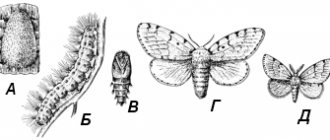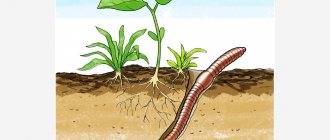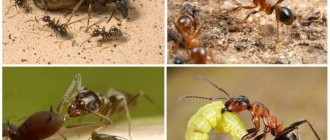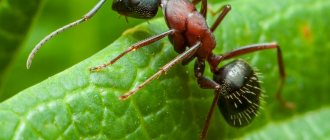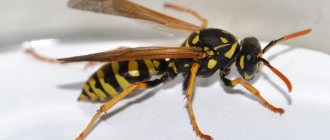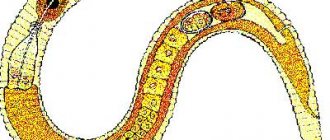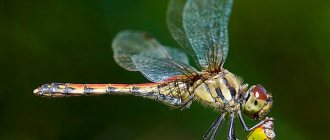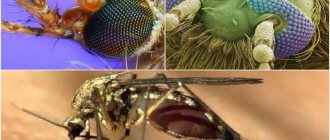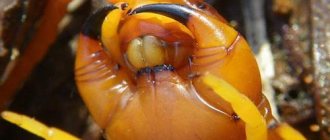- Wild animals
- >>
- Insects
The fashion industry around the world, and any person who prefers clothing made from natural fabrics, are undoubtedly connoisseurs and active consumers of a unique natural product - natural silk. If it weren't for the silkworm , we wouldn't know what silk is. It is impossible to imagine something smoother and more pleasant to the touch and surprisingly comfortable to wear as a ready-made wardrobe item.
Origin of the species and description
Photo: Silkworm
Silk production using silkworms is believed to have existed as early as the Yangshao period (around 5000 BC). Despite the fact that a huge amount of time has passed since then, the basic elements of the production process have not changed to this day. In the international classification, the silkworm is called Bombyx mori (lat.), which literally means “silk death”.
Video: Silkworm
This name is no coincidence. It arose because the main task in silk production is to prevent butterflies from flying out of the cocoon, in order to prevent damage to the silk thread entangling it. For this purpose, pupae are killed inside the cocoons by heating them to high temperatures.
Interesting fact: The dead pupae remaining after unwinding the silk thread are a fairly valuable food product in terms of their nutritional properties.
The silkworm is a butterfly from the family True silkworms. Despite the presence of wings with a span of 40-60 mm, over the long period of development of mulberry production, it has practically forgotten how to fly. Females do not fly at all, and males make short flights during the mating period.
The name eloquently indicates the habitat of these insects - mulberry trees, or mulberries, as they are commonly called in our country. The dark, sweet and juicy fruits of mulberries, similar to blackberries, are to the taste of many, but it is the leaves of these trees that are eaten by the silkworm. The larvae eat them in huge quantities, and do this around the clock, without interruption even at night. If you are nearby, you can hear the rather loud characteristic sound of this process.
After pupating, the silkworm caterpillars begin to weave a cocoon consisting of a continuous, very thin silk thread. It can be white, or it can have different shades - pink, yellow and even greenish. But in modern mulberry production, it is white cocoons that are considered valuable, so only breeds that produce white silk thread are used for breeding.
Interesting fact: Since natural silk thread is a protein product, it can dissolve under the influence of aggressive chemical detergents. This fact must be taken into account when caring for products made from natural silk.
The miracle substance sericin, or why do I need silkworm cocoons? (VIDEO)
Today's post is not simple, but experimental . I decided not to limit myself to just text and additionally format the post in video format. If this format finds a positive response from you, then I will continue to make such videos in the future.
For those who like to read more, I suggest scrolling the screen a little lower. The text with pictures begins under the video.
One day, while idly wandering around my favorite Chinese Aliexpress store, I came across an interesting product - silkworm cocoons. From the description it follows that these cocoons are intended no more and no less than for facial skin care!
Google informed me that some beauty salons already have a special one. And it costs from 1500 rubles .
On Aliexpress, cocoons cost only $3 for 100 pieces , so without any doubt, I ordered a package for myself. And after 3 weeks I received this bag of cocoons.
What effects could I expect from using cocoons?
People selling cocoons or cocoon massage services do not limit their imagination and list everything possible as expected effects: peeling, moisturizing, rejuvenation, UV protection, antibacterial action, treatment of acne and age spots, etc. In general, another panacea.
To separate the wheat from the chaff, I went to my favorite scientific literature database, PubMed, searched for “silkworm cocoons,” and started reading everything.
And this is what I managed to find out.
Silkworm
(lat. Bombyx mori) is a cute butterfly with a funny face, which was domesticated 5000 years ago. And since then, only a small part of these insects survive to the butterfly stage. Most of them face a sad fate - to die in a cocoon at the pupal stage for the benefit of humanity. According to data from the beginning of the 21st century, the annual production of silkworm cocoons reaches 1,000,000,000 kg .
Previously, humanity was only interested in the silk thread in the cocoon. And after collecting and removing the dead pupae, the cocoons were boiled in water or soap, as a result of which the substance that glues the silk threads went into solution and was not used in the future.
Now silk “glue” is finding increasing use, including in cosmetology and medicine [1].
How does a silkworm cocoon work?
The cocoon consists of 5 layers. Each layer is woven from double silk thread (70%) held together with some kind of “glue” (25%). Another 5% of the cocoon consists of waxes (0.4 - 0.8%), carbohydrates (1.2 - 1.6%), pigments (0.2%), etc. [2]
Double silk thread (mulberry) consists of a water-insoluble protein called fibroin , the structure of which has already been well studied.
As for the “glue,” until recently, ideas about its chemical structure were very vague. It was known for sure that this substance was of a protein nature. They even gave it a name - sericin .
But all the experiments indicated that it was not one protein, but several. Nevertheless, the substance was actively studied for its amino acid composition and interaction, both with model biological objects and with living beings, including humans.
And recently, using mass spectrometric analysis, Chinese scientists found that sericin consists of at least 286 proteins and peptides , each of which performs a specific function in the cocoon [3].
Such diversity is quite understandable. If the cocoon provided only mechanical protection, few pupae would survive to become butterflies. The cocoon also needs protection from UV radiation, bacteria, fungi, viruses, sudden temperature changes and other negative environmental factors.
How to use silkworm cocoons for facial care?
In order for the use of silkworm cocoons to be of any use, you must first dissolve sericin and then apply it to the surface of the skin with massaging movements.
Sericin dissolves in warm water. And the warmer it is (and even hotter), the better sericin dissolves.
You can find different instructions for soaking cocoons. Somewhere, for example, it is suggested to soak them in water at a temperature of 55° C for 5 minutes. Somewhere - in boiling water for half an hour.
My experience using cocoons suggests that the second method is more effective. Of course, with longer soaking in boiling water, part of the dissolved sericin leaves the cocoon. But if we are talking about only half an hour and if you do not stir the water during soaking, then a lot of sericin remains in the cocoon.
And when soaked for a short time in warm water, sericin dissolves poorly. And the sensations when massaging the skin are completely different.
So, put 2 cocoons in a mug and pour boiling water over them . After half an hour the water will cool down.
You put the cocoons on your index fingers and massage your face with circular movements along the massage lines as much as you are lazy. In salons, for example, this massage lasts 10-15 minutes. It takes me 5 minutes.
After the massage, let the skin dry on its own.
The instructions for the cocoons say that one cocoon can be used several times. But, to be honest, I don’t do this, because given the cheap cost of cocoons, I don’t see the point in saving money.
The water in which you soaked the cocoon can also be used for good. For example, for rinsing hair. By the way, some hairdressing salons have introduced a procedure for treating hair with sericin. This is what is called “serication of hair.” This procedure is being promoted under the slogan “Not contraindicated even for pregnant and breastfeeding women.” But I, being pregnant or breastfeeding, would still not take the risk.
What effects should we actually expect from using silkworm cocoons?
The first undoubted effect is mechanical peeling of the face, which is provided by water-insoluble silk fibers. After the massage, the skin will be very smooth.
The second undoubted effect is skin hydration. After the massage, when your skin is dry, you will feel as if there is a thin film on your face. This film has high hygroscopicity, that is, the ability to bind and retain water.
This ability is explained by the fact that sericin proteins contain about 80% hydrophilic and polar amino acids. One third of the amino acids is serine, whose ability to retain water is 50 times greater than that of glycerol [4].
Sericin proteins also contain relatively high amounts of aspartic acid, glycine, threonine, and alanine. This amino acid content is comparable to the composition of the natural moisturizing factor - a complex of substances in the stratum corneum (including free amino acids) responsible for the degree of its hydration [5].
Amino acid composition of sericin and fibroin
Amino acid composition of natural moisturizing factor
I was able to find an article that describes the results of using a sericin solution as a moisturizer on 6 volunteers [6]. The selection is certainly terrible. But some trends have emerged, so I’ll tell you in a little more detail.
Experiment
To prepare the moisturizing gel, sericin was extracted from the cocoon by autoclaving in distilled water for 30 min at 105°C. The resulting extract was concentrated using a vacuum concentrator.
The study group consisted of 6 people (3 women, 3 men) aged 22-25 years. The gel was applied to the inner surface of one of the forearms, the second forearm served as a control.
As a result of the experiment, some characteristics of the skin on which the gel was applied changed. In particular, in the skin:
-increased content of the amino acid hydroxyproline (an important indicator of skin health),
- the electrical resistance of the skin to alternating current (impedance) has decreased, which indicates that the skin has become more hydrated,
- transepidermal moisture loss has decreased.
The texture of the skin has also changed: it has become smoother, and the number of grooves has decreased.
Skin texture before (left) and after (right) sericin treatment
Wound healing effect
In one experiment on rats, it was shown that a cream containing 8% sericin accelerates wound healing compared to the same cream without sericin [7].
Healing of a wound that was treated with a cream with sericin Healing of a wound that was treated with a cream without sericin
Experiments on cell cultures, including humans, have shown that at a certain concentration in the nutrient medium, sericin has a mitogenic effect, that is, it promotes cell division (proliferation) [8].
Judging by the publications, there is currently an active development of special materials from sericin that could be used to heal wounds of various origins [9].
Therefore, it can be assumed that regular massage with cocoons will help heal some wounds on the skin. Although it is hardly worth directly massaging the wound.
Should we expect a rejuvenating effect?
When they talk about the rejuvenating effect of any product, they primarily mean increased collagen production, the manifestation of antioxidant properties and the fight against signs of photoaging, in particular, age spots.
And although in advertising texts you can find loud statements that massage with silkworm cocoons promotes the production of collagen in the skin, in reality this has not yet been proven.
The only experiment I came across concerned sericin and collagen [10]. In it, sericin was added to the nutrient medium in which the culture of mouse fibroblasts grew. (Fibroblasts are a type of connective tissue cell. In the skin, they are responsible for the production of collagen.) After adding sericin, extracted by certain methods, the culture of fibroblasts began to produce more collagen.
The effect of sericin on collagen synthesis by mouse fibroblast cell culture. The four graphs correspond to the four methods of sericin extraction.
How comparable a culture of mouse fibroblasts in a Petri dish is to human skin is up to you to decide.
The antioxidant properties of sericin and the ability to suppress the activity of the tyrosinase enzyme have also been demonstrated only in vitro [11, 12]. (Tyrosinase is the enzyme that catalyzes the conversion of tyrosine to melanin, the skin pigment.)
Therefore, the rejuvenating effect of sericin, in my opinion, has so far been written with a pitchfork.
Prevention of photoaging
Using hairless mice, it was shown that when rodents are repeatedly irradiated with ultraviolet radiation, pre-treatment of the irradiation area with an alcoholic solution of sericin reduces the number and severity of damage caused [13].
The effect of sericin on collagen synthesis by mouse fibroblast cell culture. The four graphs correspond to the four methods of sericin extraction.
Antibacterial action
Experiments show that neither fibroin nor sericin are able to slow down the growth of E. coli on a nutrient medium in a Petri dish [14].
However, the human skin microbiome (that is, the quantitative and species composition of microorganisms living on human skin) is far from limited to E. coli. Therefore, further experiments are necessary.
To summarize today's post, I want to say the following.
By massaging your facial skin with silkworm cocoons, you have every right to expect exfoliation and hydration of your skin. The remaining effects on humans have not yet been proven by scientists.
However, on the popular resource of popular reviews, IRecommend, many women claim that facial skin massage with cocoons has significantly helped them in the fight against imperfections. I have no reason not to believe these women, since none of them promote a specific seller. They all bought cocoons from the same Aliexpress store as me, but from different sellers.
So I will continue to use cocoons. I can already feel the exfoliating and moisturizing effects. I hope that pimples and imperfections will also gradually go away.
If you also decide to purchase silkworm cocoons, you can order them here>>
Carefully!
The only thing I simply have to warn you against is allergies. You should definitely try the cocoons on the inside of your forearm first, especially if your skin is prone to allergies.
As a postscript...
Ironically, when I was writing this post, I received an email from the liters bookstore to read the book “The Silkworm” by a certain Robert Galbraith. It turned out that behind this pseudonym is the famous JK Rowling, the author of the most popular series of books about Harry Potter.
Apparently tired of her boy wizard, Joan decided to write a crime mystery novel for adults. And I must say that she did a good job. Therefore, if you are interested in what kind of detective story an author of children's books can write, take a look here>>
The post was prepared based on articles:
- Chen F., Porter D., Vollrath F. Structure and physical properties of silkworm cocoons. JR Soc Interface. 2012 Sep 7;9(74):2299-308.
- Mondal M., Trivedy K., Nirmal Kumar S. The silk proteins, sericin and fibroin in silkworm, Bombyx mori Linn., - a review. Caspian J. Env. Sci. 2007, Vol. 5 No. 2 pp. 63-76.
- Zhang Y., Zhao P., Dong Z., Wang D., Guo P., Guo X., Song Q., Zhang W., Xia Q. Comparative proteome analysis of multi-layer cocoon of the silkworm, Bombyx mori. PLoS One. 2015 Apr 10;10(4):e0123403.
- Patel RJ, Modasiya MK Sericin: Pharmaceutical Applications. IJRPBS. 2011, Vol. 2 (3)
- Rangi A., Jajpura L. The Biopolymer Sericin: Extraction and Applications. J Textile Sci Eng 5:188.
- Padamwar MN, Pawar AP, Daithankar AV, Mahadik KR Silk sericin as a moisturizer: an in vivo study. J Cosmet Dermatol. 2005 Dec;4(4):250-7.
- Aramwit P., Sangcakul A. The effects of sericin cream on wound healing in rats. Biosci Biotechnol Biochem. 2007 Oct;71(10):2473-7.
- Sato W., Fukumoto K., Yanagihara K., Sasaki M., Kunitomi Y., Terada S. Mitogenic effect of sericin on mammalian cells. BMC Proc. 2011 Nov 22;5 Suppl 8:P121.
- Aramwit P., Siritientong T., Srichana T. Potential applications of silk sericin, a natural protein from textile industry by-products. Waste Manag Res. 2012 Mar;30(3):217-24.
- Aramwit P., Kanokpanont S., Nakpheng T., Srichana T. The effect of sericin from various extraction methods on cell viability and collagen production. Int J Mol Sci. 2010 May 20;11(5):2200-11.
- Kato N., Sato S., Yamanaka A., Yamada H., Fuwa N., Nomura M. Silk protein, sericin, inhibits lipid peroxidation and tyrosinase activity. Biosci Biotechnol Biochem. 1998 Jan;62(1):145-7.
- Manosroi A., Boonpisuttinant K., Winitchai S., Manosroi W., Manosroi J. Free radical scavenging and tyrosinase inhibition activity of oils and sericin extracted from Thai native silkworms (Bombyx mori). Pharm Biol. 2010 Aug;48(8):855-60.
- Zhaorigetu S., Yanaka N., Sasaki M., Watanabe H., Kato N. Inhibitory effects of silk protein, sericin on UVB-induced acute damage and tumor promotion by reducing oxidative stress in the skin of hairless mice. J Photochem Photobiol B. 2003 Oct 15;71(1-3):11-7.
- Kaur J., Rajkhowa R., Afrin T., Tsuzuki T., Wang X. Facts and myths of antibacterial properties of silk. Biopolymers. 2014 Mar;101(3):237-45.
Save
Save
Appearance and features
Photo: Silkworm butterfly
Externally, the silkworm is rather inconspicuous; an adult individual looks like an ordinary moth or a large moth. It has large wings of gray or off-white color with clearly “drawn” dark veins. The body of the silkworm is quite massive, completely covered with a dense layer of light fibers and visually divided into transverse segments. There is a pair of long antennae on the head, similar to two combs.
If we talk about the life cycle of the silkworm, it is necessary to distinguish between wild insects and domesticated breeds. In captivity, the silkworm does not survive to the butterfly stage and dies in the cocoon.
Its wild counterparts manage to live through all four stages characteristic of insects of any species:
- egg;
- caterpillar (silkworm);
- chrysalis;
- butterfly.
The larva that emerges from the egg is very small, only about three millimeters long. But as soon as it begins to eat the leaves of the mulberry tree, doing this continuously day and night, it gradually increases in size. In just a few days of its life, the larva manages to survive four molts and eventually turns into a very beautiful pearl-colored caterpillar. Its body length is about 8 cm, thickness is about 1 cm, and an adult weighs about 3-5 g. The caterpillar's head is large, with two pairs of well-developed jaws. But its main feature is the presence of special glands ending in an opening in the oral cavity, from which it releases a special liquid.
Interesting fact: Due to the exceptional strength of natural silk thread, it is used in the production of body armor.
When it comes into contact with air, this liquid hardens and turns into that famous and unique silk thread, which is so valued in mulberry production. This thread serves as material for silkworm caterpillars to build cocoons. Cocoons come in completely different sizes - from 1 to 6 cm, and various shapes - round, oval, with jumpers. The color of cocoons is most often white, but can have colored shades - from yellowish-golden to purple.
Now you know what a butterfly and silkworm caterpillar look like. Let's see where the silkworm lives.
Types of silkworms
Other types of silkworms belong to other families. Most of them are pests of forest and fruit crops. Let's look at some varieties.
Pine
The pine silkworm is also called the cocoon moth; it belongs to the family of the same name. Caterpillars feed on pine trees, eating needles of varying maturity, sometimes entire branches.
The butterflies are large grayish-brown, the wingspan of females reaches 8.5, males - 6 cm. The color of the wings largely adapts to the color of the bark of the trees on which the cocoon moths settle. Butterflies can be identified by a small white spot in the middle of the front wings.
The caterpillars are shaggy, grayish carpet-colored, 6-8 cm long. The hairs have a reddish tint, and there are ring constrictions on the body. On the second and third chest constrictions, the cutouts are dark blue. The hibernating stage is the caterpillar. Cocoons with pupae are gray and form in early June on pine branches. The silkworm weaves a web around large branches. In nature, cocoon moths are eaten by cuckoos, their natural enemies are parasites and microscopic fungi.
Ringed
Also belongs to the family of cocoon moths, widespread throughout Europe and Asia. It is a pest of forest and garden crops. The color of the butterflies is yellow-red-brown, length 3-4 cm. The caterpillar is dark with distinct yellow-orange stripes, covered with long hairs. The egg laying is light gray in a ring around thin branches.
Nun
A butterfly from the moth family, a typical night moth. Caterpillars prefer to feed at night, making them difficult to spot in gardens. Causes significant damage by eating leaves of apple, oak, birch, and coniferous trees - pine, spruce, larch. Juniper, yew, pear, privet, currant and gooseberry are not subject to invasions of nuns. The wingspan of butterflies is up to 6 cm, the color is gray with a typical dark pattern in the form of zigzag stripes. The antennae are black, jagged.
The caterpillar is densely covered with hairs with 8 pairs of legs, 6 cm long. On the back there is a black spot in the shape of a heart, from which a dark stripe runs along the body. Red warty spots are visible on the ninth and tenth ring constrictions. Overwintering stage - eggs laid in folds of bark. The caterpillars are very voracious, producing webs on which they can be carried by the wind and cause outbreaks in large areas of forested areas. Each outbreak lasts 7-8 years, after which the number declines.
Unpaired
Belongs to the Volnyanka family. Widely distributed in Eurasia, it was introduced to North America. The damage caused by the insect consists of the death of forest and fruit crops. Valuable tree species are especially affected - oak and linden, plum, apple tree. Caterpillars do not eat pear, ash and alder trees.
Butterflies of different sexes differ from each other. Females are large, reaching 9 cm when the wings spread, light red or white. Males have a wingspan of up to 4 cm and are brownish-yellow. Flight occurs in the second half of summer, they fly low above the ground, after mating they lay eggs in bark cracks on trunks and trunks, stumps, and fences. Therefore, trapping belts worn on the trunks of fruit trees are effective against them.
The caterpillar is hairy, 6-7 cm long with wart spots. The first five pairs of warts are blue, less noticeable, the back six pairs are distinct red. Clutches of eggs can be recognized by their shaggy, reddish-brown covering. Eggs have high vitality.
Where does the silkworm live?
Photo: Silkworm in Russia
It is believed that the birthplace of the modern silkworm is China. Already in the period 3000 BC. its mulberry groves were inhabited by a wild species of insect. Subsequently, its active domestication and spread throughout the world began. In the northern regions of China and in the south of the Primorsky Territory of Russia, wild breeds of silkworms still live today, from which, presumably, the spread of the species throughout the world began.
The habitat of the silkworm today is determined by the development of mulberry production. In order to spread it, insects were brought to many areas with a suitable climate. So, at the end of the 3rd century AD. colonies of silkworms inhabited India, and a little later moved to Europe and the Mediterranean.
For comfortable living and production of silk thread, the silkworm requires certain climatic conditions, without which the insect does not perform the main function consumed by silkworms - it does not form cocoons and does not pupate. Therefore, its habitats are areas with a warm and moderately humid climate, without sudden temperature changes, with an abundance of vegetation, and in particular, mulberry trees, the leaves of which are the main food of the silkworm.
China and India are considered the main habitat of the silkworm. They produce 60% of the world's silk. But thanks to this, sericulture has become one of the important industries in the economy of many other countries; today, silkworm colonies inhabit areas of Korea, Japan, Brazil, and in the European part they are common in certain regions of Russia, France and Italy.
Types of caterpillars - photos and names.
Among the great variety of different caterpillars, the following varieties are of greatest interest:
The cabbage caterpillar or cabbage butterfly caterpillar (cabbage white butterfly) (lat. Pieris brassicae) lives throughout Eastern Europe, northern Africa to the Japanese islands, and was also introduced to South America. The caterpillar is 3.5 cm long, has 16 legs and has a light green body covered with black warts and short black hairs. Depending on the weather, the caterpillar stage lasts from 13 to 38 days. These caterpillars feed on cabbage, horseradish, radishes, turnips, turnips and shepherd's purse. They are considered the main pest of cabbage.
The moth (land surveyor) caterpillar (lat. Geometridae) is characterized by a long thin body and undeveloped abdominal legs, due to which it has an original method of movement - it bends in a loop, while pulling the abdominal legs to the pectoral legs. The family includes more than 23 thousand species of moths distributed throughout the world. All types of caterpillars of this family have well-developed muscles, and therefore are able to attach themselves vertically to plants, perfectly imitating broken branches and petioles. The color of the caterpillars is similar to the color of foliage or bark, which additionally serves as an excellent camouflage. They eat tree needles, currants and hazel.
The great harpy caterpillar (lat. Cerura vinula = Dicranura vinula) lives throughout Europe, Central Asia and northern Africa. Adult caterpillars grow up to 6 cm and are distinguished by a green body with a purple diamond on the back, bordered by a white outline. In case of danger, the caterpillar inflates, takes a threatening pose and sprays out a caustic substance. The insect remains in the caterpillar stage from early summer to September, feeding on the leaves of plants from the willow and poplar families, including the common aspen.
The red-tailed caterpillar (lat. Calliteara pudibunda) is found in the forest-steppe zone throughout Eurasia, as well as in Asia Minor and Central Asia. The caterpillar, up to 5 cm long, is pinkish, brown or gray in color. The body is densely covered with individual hairs or tufts of hair, at the end there is a tail of protruding crimson-colored hairs. This is a poisonous caterpillar: upon contact with human skin, it causes a painful allergy. These caterpillars eat the foliage of various trees and shrubs, especially preferring hops.
Silkworm caterpillar (lat. Bombyx mori) or silkworm. Lives in East Asia: in northern China and Russia, in the southern regions of Primorye. The caterpillar is 6-7 cm long, its wavy body is densely covered with blue and brown hairy warts. After 4 molts, completing the 32-day development cycle, the color of the caterpillar becomes yellow. The food of the silkworm caterpillar is exclusively mulberry leaves. This insect has been actively used in sericulture since the 27th century BC. e.
Caterpillar of the corrosive woodworm (lat. Zeuzera pyrina) from the woodworm family. It is found in all European countries except the Far North, as well as in South Africa, Southeast Asia and North America. It overwinters twice, during which time it changes color from yellow-pink to yellow-orange with black, glossy warts. The length of the insect is 5-6 cm. Caterpillars live inside the branches and trunks of various trees, feeding on their juices.
The caterpillar of the lady bear (lat. Callimorpha dominula) or girl bear lives in Eastern and Western Europe and in southeast Asia. It overwinters once and is distinguished by its black and blue color with yellow stripes and spots. Lives on nettles, geraniums, willows, raspberries, strawberries, and feeds on them.
The swallowtail caterpillar (lat. Papilio machaon) lives throughout Europe, Asia, northern Africa and North America. One of the most colorful caterpillars: at first black, with scarlet warts, and as it grows it becomes green with black transverse stripes. Each stripe contains 6-8 red-orange spots. The disturbed caterpillar secretes an odorous orange-yellow liquid. It feeds on carrots, celery, wormwood, parsley, and sometimes alder leaves.
The smallest caterpillar in the world is a member of the moth family. For example, clothes moth caterpillars (lat. Tineola bisselliella), which have just emerged from eggs, reach a length of only 1 mm.
The largest caterpillar in the world is the Atlas peacock caterpillar (lat. Attacus atlas). The bluish-green caterpillar, as if dusted with white dust, grows up to 12 cm in length.
What does the silkworm eat?
Photo: Silkworm cocoons
The main diet of the silkworm is best described by its name. It feeds exclusively on the leaves of the mulberry tree, which is also called mulberry or mulberry. Seventeen varieties of this plant are known, which are distributed exclusively in warm climates - the subtropical zones of Eurasia, Africa and North America.
The plant is quite capricious and grows only in comfortable conditions. All its species are fruit-bearing and have tasty, juicy fruits that look like blackberries or wild raspberries. The fruits vary in color - white, red and black. Black and red fruits have the best aroma; they are widely used in cooking for making desserts and baking, and they are also used to make wine, mulberry vodka and soft drinks.
White and black mulberries are widely cultivated for mulberry production. But the fruits of these trees are not of interest to the silkworm; it feeds exclusively on fresh mulberry leaves. Under natural conditions, mulberry groves are densely populated by this insect. Sericulture breeders who want to get a lot of silk cocoons take care of the plantings of this plant, look after them, creating comfortable conditions for growth - a sufficient amount of moisture and protection from the scorching sun.
On mulberry farms, silkworm larvae continuously supply fresh portions of crushed mulberry leaves. They eat constantly, day and night. In the room where the trays with colonies of larvae are located, there is a characteristic hum from working jaws and the crunching of mulberry leaves. From these leaves, silkworms obtain all the necessary substances for the reproduction of valuable silk thread.
What are silk cocoons
Silkworm cocoons are a unique natural product that cares for the face. In ancient times, the Chinese and residents of eastern Europe used the product for these purposes. The dynasty of Japanese emperors owned a silkworm farm. Cocoons were used daily for skin care. They were valued as giving youth and energy.
Today they are an indispensable component of cosmetics in Asian countries. Anti-aging effect. Brightening. Refreshing.
Suppliers offer silk cocoons in packs of 5-15 pieces, by weight. They can be stored without loss of quality for over three years. Increased moisture content in the air softens the walls. Bright rays of the sun lead to darkening. One is useful four to five times.
Features of character and lifestyle
Photo: Silkworm caterpillar
The centuries-old development of silk production has left its mark on the way of life of the silkworm. It is assumed that wild individuals at the dawn of their appearance were excellent at flying, as evidenced by the presence of fairly large wings in this species of insects, quite capable of lifting the body of a silkworm into the air and transporting it over a considerable distance.
However, under domestication conditions, insects practically forgot how to fly. This is due to the fact that most individuals do not survive to the butterfly stage. Sericulture breeders kill the larvae immediately after the formation of the cocoon so that the butterfly leaving it does not damage the precious silk thread. In nature, silkworm butterflies are quite viable, but evolutionary changes have affected them too. Males are slightly more active and make short flights during the mating season.
Interesting fact: Female silkworms can live their entire short lives - about 12 days - without making a single beat of their wings.
There is evidence that mature silkworms do not eat at all. Unlike the previous form of their life cycle - the caterpillar, which has powerful jaws and continuously absorbs food - butterflies have an underdeveloped oral apparatus and are unable to grind even the lightest food.
Over a long period of domestication, insects became completely lazy; it became difficult for them to survive without human care and tutelage. Silkworms do not even try to find food on their own, waiting to be fed ready-to-eat, finely chopped mulberry leaves. In nature, caterpillars are more active; it is even known that when there is a lack of usual food, they sometimes feed on the foliage of other plants. However, the silk thread produced from such a mixed diet is thicker and coarser, and is not of sufficient value in silk production.
Dietary features and lifestyle
In the life cycle of the silkworm, four stages of development are clearly distinguished:
- egg (grena);
- caterpillar (larva);
- pupa in a cocoon;
- butterfly (adult, imago).
Silk producers from different countries choose breeds and hybrid forms of silkworms that differ from each other in physiological and economically valuable characteristics, and are most adapted to local climatic and organizational and economic conditions. The fundamental difference between the breeds is the annual number of generations of workers:
- one - monovoltine;
- two – bivoltine;
- several are multivoltine.
Let us consider in more detail the characteristics of each period in the life cycle of an insect.
Silkworm eggs are very small; one gram contains 1500-2000 eggs. One female lays 500-700 eggs. Greens are oval in shape, slightly flattened on the sides, and have an elastic translucent shell - a white or light yellow shell. After laying, the eggs begin their development during the first two days, which is externally manifested in a change in the color of the shell from light to pink and purple, and its hardening.
The optimal temperature for incubation (winter storage) is 2-4o C. Such conditions allow the larvae to hatch simultaneously with the opening of the mulberry leaves.
Caterpillar
Silkworm larvae are called silkworms, but according to their biological characteristics they are caterpillars. In appearance, their body is elongated, the head, chest and abdomen, ending in a horny appendage, are clearly distinguishable. There are 8 pairs of legs: 3 pairs of thoracic and 5 abdominal. The outside of the body is covered with a chitinous cover without pubescence - this is the exoskeleton, muscles are attached to it.
In the development of caterpillars, five instars are distinguished, one more than the number of molts. The lifespan of the organism is 20-38 days. During this short period, the size of the body increases by 30 times, and the mass by tens of thousands of times. During the molting period, the caterpillar looks for an attachment site. To do this, she uses her abdominal legs, and the front part of her body rises.
After molting, the return to increased nutrition occurs slowly. It will take some time until the new cover becomes harder and more durable. Along with this, the legs become larger and acquire hooks.
The color of caterpillars varies depending on age:
- in the first instar dark brown or black;
- in the second, a light color appears on the chest;
- in the third and fourth - carpet coloring;
- in the fifth it is white or light green.
The structure of the silk gland consists of the following sections:
- fibrin secretion department;
- a tank for storing it;
- excretory ducts (paired and unpaired).
In the unpaired duct they find the so-called “drawing machine” - a device found in the insect, the structure of which determines the thickness of the silk thread.
At the end of the fifth instar, which lasts 8-12 days, the caterpillars are completely covered with a cocoon, molting occurs inside, after which the caterpillar inside the cocoon turns into a pupa.
Doll
The process of turning a caterpillar into a pupa - pupation - takes 4-5 days. The pupal stage is a complex continuous process of quantitative and qualitative changes in the insect’s body, lasting 12-18 days, as a result of which a butterfly emerges from the cocoon.
About a day before the butterfly emerges, there is noticeable movement and slight noise in the cocoon. The future butterfly first sheds the outer covers of the pupa, then secretes a liquid that dissolves the adhesive substance sericin, which glued the threads of the cocoon. The butterfly emerges strictly from 5 to 6 am.
Social structure and reproduction
Photo: Silkworm
The silkworm is a paired insect that reproduces and has the same life cycle as most butterflies. Currently, many of its species have been bred. Some give birth only once a year, others - twice, but there are also those that are capable of laying eggs several times a year.
During the mating period, males become more active and even make short flights, which is unusual for them in normal times. In nature, one male can fertilize several females. On artificial farms, at the onset of mating season, silkworm breeders place paired insects in separate bags and wait 3-4 days after mating until the female lays eggs. On average, a silkworm clutch contains from 300 to 800 eggs. Their number and size depend on the breed of insect, as does the hatching period of the caterpillar. There are more productive types of silkworms that are most in demand among silkworm breeders.
In order for a worm to hatch from an egg, an ambient temperature of about 23-25 degrees and moderate humidity are required. In mulberry production, these conditions are created artificially by incubator employees, but in nature, laid eggs are forced to wait for favorable conditions for several days. Silkworm eggs hatch into tiny larvae (or silkworms) about 3 mm in size and brown or yellowish in color. From the moment they are born, the larvae begin to eat, and their appetite grows every day. After only a day, they are able to eat twice as much food as the day before. It is not surprising that with such an abundant diet, the larvae quickly grow into caterpillars.
On the fifth day of life, the larva finally stops eating and freezes without moving, so that the next morning, straightening up with a sharp movement, sheds its first skin. Then she starts eating again, devouring it with great appetite for the next four days, until the next molting cycle. This process is repeated four times. As a result, the silkworm larva turns into a very beautiful caterpillar with pearl-colored skin. By the end of the molting process, she has already formed an apparatus for producing silk thread. The caterpillar is ready for the next stage - spinning a silk cocoon.
By this time, she loses her appetite and gradually refuses to eat at all. Its silk-secreting glands are filled with liquid, which is secreted outward and trails the caterpillar everywhere with a thin thread. The caterpillar begins the pupation process. She finds a small twig, twists the future frame for the cocoon on it, crawls into its center and begins to twist the thread around herself, actively working with her head.
The pupation process lasts an average of four days. During this time, the caterpillar manages to use from 800 m to 1.5 km of silk thread. Having finished forming the cocoon, the caterpillar falls asleep inside it and turns into a pupa. After three weeks, the pupa becomes a butterfly and is ready to emerge from the cocoon. But the silkworm butterfly has jaws that are too weak to gnaw a hole in the cocoon to escape. Therefore, a special liquid is secreted in its oral cavity, which, wetting the walls of the cocoon, corrodes them, clearing the way for the butterfly to exit.
In this case, the continuity of the silk thread is disrupted and unwinding the cocoons after the butterfly has flown out becomes a labor-intensive and ineffective process. Therefore, in mulberry farms, the silkworm's life cycle is interrupted at the pupation stage. Most cocoons are exposed to high temperatures (about 100 degrees), at which the larva inside dies. But the cocoon, consisting of the finest silk thread, remains intact.
Sericulture breeders leave a certain number of individuals alive for the purpose of their further reproduction. And the dead larvae left after unwinding the cocoons are readily eaten by residents of China and Korea. The natural life cycle of the silkworm ends with the appearance of a butterfly, which, a few days after leaving the cocoon, is ready to reproduce.
Reproduction and lifespan
It all starts with eggs, which the silkworm calls grenas. The term comes from the French graine, which translates as grain. The silkworm is deprived of the opportunity to choose a place for laying and provide incubation conditions.
Silkworm breeders, specialists in raising silkworms, are tasked with providing the necessary temperature, humidity and air access. Thermal conditions are the determining factor for successful incubation.
When breeding caterpillars, do two things:
- maintain the ambient temperature almost constant throughout the incubation period,
- increase it by 1-2 °C daily.
The starting temperature is 12 °C, the temperature rise ends at 24 °C. Having reached the maximum incubation temperature, the process of waiting for the silkworm caterpillar . A decrease in temperature during the incubation process, including an unplanned one, is not dangerous for greenns. A temperature rise of up to 30 °C can be fatal.
Incubation usually ends on the 12th day. The silkworm then lives in the form of a caterpillar. This phase ends after 1-2 months. The pupa exists for about 2 weeks. The emerging butterfly has several days to fertilize and lay eggs.
Natural enemies of the silkworm
Photo: Silkworm butterflies
In the wild, the enemies of the silkworm are the same as those of other insect species:
- birds;
- insectivores;
- parasitic insects;
- pathogenic microorganisms.
As for birds and insectivorous animals, the picture is clear with them - they eat both caterpillars and adult silkworm butterflies. The fairly large size of both makes for attractive prey.
But there are certain types of natural enemies of the silkworm that act more sophisticatedly and cause much more harm to its populations. Among the parasitic insects, the most dangerous for silkworms are hedgehog flies or tahini (family Tachinidae). The female hedgehog lays eggs on the body or inside the silkworm, and parasitic larvae develop in its body, ultimately leading to the death of the insect. If the infected silkworm manages to survive, it reproduces the infected offspring.
Another deadly threat to silkworms is pebrine disease, which is caused by a pathogen scientifically named Nosema bombycis. The disease is transmitted from an adult infected individual to its larvae and leads to their death. Perbina is a real threat to silk production. But modern silkworm breeders have learned to effectively combat its pathogen, as well as parasitic insects that pose a danger to cultivated individuals.
Interesting fact: In its natural environment, the silkworm is forced to confront enemies on its own. It is known that caterpillars infected with parasites begin to eat plants containing toxic alkaloids. These substances have a detrimental effect on the parasite larvae, giving the infected caterpillar a chance to survive.
Gypsy moth caterpillar
Unlike its cousin the silkworm, which most can only see in photographs because it is not found in the wild, the gypsy moth does not provide any benefit to humans. And even vice versa.
In an insect called the gypsy moth, the caterpillar does the most damage. Their feeding period lasts 35-50 days, which is the same or even longer than the flowering time of some fruit plants. Therefore, if you do not get rid of the caterpillars in time, you may be left without a harvest.
It is quite easy to recognize the pest:
- length 6-7 cm,
- the body is tuberous, covered with blue and brown warts from which hairs grow,
- There are two light stripes along the back.
Outwardly, the gypsy moth caterpillar looks unpleasant; few people would want to pick it up with their hands, but it is necessary to get rid of it.
Corrosive woodworm and the fight against butterfly pests
- a large butterfly, the wingspan of which reaches 7 cm. Its white wings are covered with numerous blue-black spots.
Woodworm caterpillars are covered with hairs, which helps them spread over long distances with the wind.
The insect damages all fruit crops and many forest trees.
The laying of eggs by females continues until mid-August. Each of them is capable of depositing up to 1000 pieces in cracks in the bark and branching shoots.
The emerging caterpillars begin to damage young shoots of trees, biting into them. The leaves on such shoots dry out and die.
Caterpillars overwinter on tree branches and in passages made in them. Next season, the caterpillars have not yet become butterflies.
Only in the third season do the caterpillars gnaw exit holes, pupate inside the branch and then fly out.
In addition, you can stuff cotton balls soaked in gasoline into the passages made by the tree. After this, the entrance holes should be covered with clay.
From the beginning of August until the onset of leaf fall, it is recommended to periodically inspect the crowns of trees and remove young shoots damaged by woodworm.
When infested by corrosive woodworm caterpillars, it is recommended to spray the trees with a concentrated solution of chlorophos, but only after harvesting.
In this case, you should first spray only a few shoots of the tree to eliminate the possibility of burning the branches with concentrated chlorophos.
